Native Instruments Traktor DJ Studio 3.0 Operation Manual
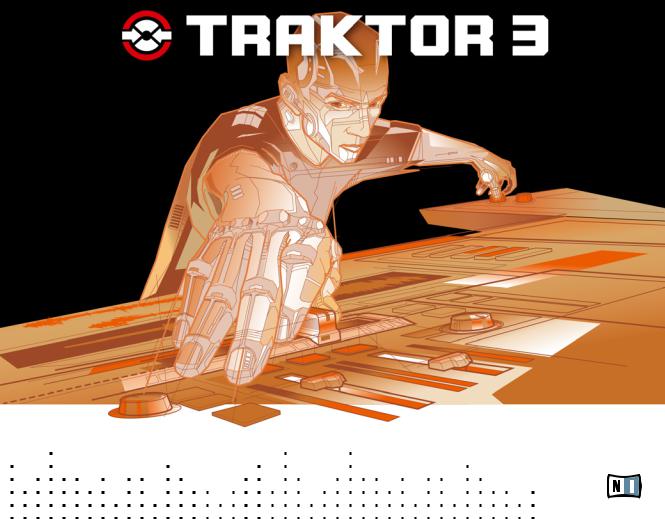
OPERATION MANUAL
The information in this document is subject to change without notice and does not represent a commitment on the part of NATIVE INSTRUMENTS GmbH. The software described by this document is subject to a License Agreement and may not be copied to other media. No part of this publication may be copied, reproduced or otherwise transmitted or recorded, for any purpose, without prior written permission by NATIVE INSTRUMENTS GmbH, hereinafter referred to as NATIVE INSTRUMENTS. All product and company names are ™ or ® trademarks of their respective owners.
Furthermore, the fact that you are reading this text means you are the owner of a legal version rather than an illegal, pirated copy. It is only through the loyalty and honesty of people like yourself that NATIVE INSTRUMENTS GmbH can continue to develop and create innovative audio software. On behalf of the entire company, thank you very much.
Written and revised by:
Irmgard Bauer, Friedemann Becker, Robert Kotok (Version 3)
Other valuable input from:
PhilL, Hobbes, Quartz, AudioRapture and all TRAKTOR Forum Users!
Special thanks go to the beta test team, who were invaluable not just in tracking down bugs, but in making this a better product!

Germany
NATIVE INSTRUMENTS GmbH Schlesische Str. 28
D-10997 Berlin Germany
info@native-instruments.de www.native-instruments.de
USA
NATIVE INSTRUMENTS North America, Inc. 5631 Hollywood Boulevard
Los Angeles, CA 90028 USA
sales@native-instruments.com www.native-instruments.com
© Native Instruments GmbH, 2007. All rights reserved.
1. Welcome Words
Dear Customer,
Thank you for choosing TRAKTOR 3!
As a legal owner of this software you contribute to the maintenance of the software and to the creation of future updates.
Since spring 2007 TRAKTOR 3 has a new brother called TRAKTOR Scratch. Version TRAKTOR 3.3 merges both worlds by connecting the intuitiveness of turntable controlled playback with the powerful sync and loop tools for which TRAKTOR is known.
This happens after 8 years of TRAKTOR history, initiated by a group of three developers in 1999. In these years, the software has grown to a serious project that covers a large variety of user profiles from dance to hip hop and from bedroom to main floor.
We wish you a great and successful time when driving TRAKTOR 3! Friedemann Becker
TRAKTOR 3.3 –
2. System Requirements
For latest system requirements, compatibility and support of the latest operating systems please see our website at:
http://www.native-instruments.com/traktor3
TRAKTOR 3.3 –
3. Installation
This chapter explains you in an easy step-by-step explanation how to install TRAKTOR 3 on your computer.
3.1 Start – The Splash Screen
Insert the TRAKTOR 3 CD in the CD-drive of your computer.
►On a PC, double-click on “My Computer” then double-click on the TRAKOR 3 CD Icon to open the content of the CD. Double-Click Traktor_3_Installation_ Menu.
►On a Mac, the TRAKTOR 3 CD icon will be displayed on the desktop. Click on it to open the content of the CD. Click on Traktor_3_Installation_Menu.
This starts the TRAKTOR 3 Splash Screen that lets you choose between different possible actions. Follow the forthcoming chapters to make the right decisions regarding the needed installations for your package and the right order of these installations.
TRAKTOR 3.3 –
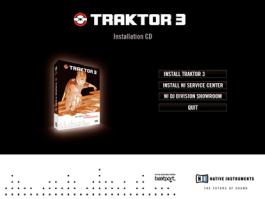
3.2 Windows XP Installation
This section describes the installation and the uninstall processes on a Windows PC.
3.2.1 Installing TRAKTOR 3
►On the Splash Screen, choose Install TRAKTOR 3.
►A dialog opens that welcomes you to the installation of TRAKTOR 3. Click on Next to proceed.
►In the next window, you are prompted to agree to the license agreement. Click on I Accept to proceed.
►The next window lets you choose an installation folder. Click Next to proceed with the default installation folder.
TRAKTOR 3.3 –
►In the next screen you can choose a program group where the TRAKTOR 3 icon will be added to. You should leave it in the default path and proceed with
Next.
►Now the installation is running. At the end of this process, a dialog asks you whether you want to see the Welcome.pdf, create a shortcut on the desktop, start TRAKTOR 3 now and/ or start the NI Service Center Setup. Choose the options you want, and then click on Finish to finish the installation.
3.2.2 Uninstalling TRAKTOR 3
To uninstall TRAKTOR 3 from your computer, use the following steps:
►Open C:\Program Files\Native Instruments\Traktor DJ Studio 3.
►Double-click the Unwise tool to begin un-installation.
►Choose Automatic from the following dialog.
3.2.3 Installing NI SERVICE CENTER
►On the Splash Screen, choose Install NI Service Center.
►A dialog opens that welcomes you to the installation of NI Service Center. Click on Next to proceed.
►In the next window, you are prompted to agree to the license agreement. Click on I Accept to proceed.
►The next window lets you choose an installation folder. Click Next to proceed with the default installation folder.
►On the next screen you can choose a program group where the TRAKTOR Scratch icon will be added to. You should leave it in the default path and proceed with Next.
►Now the installation is running. At the end of this process, a dialog asks you whether you want to start the Service Center now, open the Readme or create a shortcut on the desktop. Choose the options you want, and then click on Finish to finish the installation.
!Please always refer to the Readme file on the installation CD as it contains last minute information not available
in the printed manual.
TRAKTOR 3.3 –
3.3 Mac OS X Installation
This section describes the installation and the uninstall processes on a Macintosh computer.
3.3.1 Installing TRAKTOR 3
► On the Splash Screen, choose Install TRAKTOR 3.
► The next screen shows the license agreement. Click on Continue to proceed. ► In the next window you can choose an installation destination. Click Continue
to proceed with the default path. |
|
► In the next window you can choose the installation type. Click on Install to |
Please always refer to |
proceed. |
!the Readme file on the |
► When the installation is finished a new window informs you that you can com- |
installation CD as it contains last |
plete the installation process by clicking on Quit. |
minute information not available |
|
in the printed manual. |
3.3.2 Uninstalling TRAKTOR 3 |
|
To uninstall TRAKTOR 3 from your computer, please delete the following files |
|
manually: |
|
/Applications/Traktor DJ Studio 3/Library/Preferences/com.native-instruments.TraktorDJStudio3. |
|
plist |
|
TRAKTOR 3.3 –
3.3.3 Installing NI SERVICE CENTER
►On the Splash Screen, choose Install NI Service Center.
►The next screen shows the license agreement. Click on Continue to proceed.
►In the next window you can choose an installation destination. Click Continue to proceed with the default path.
►The next window lets you install the Flash Player that is needed for the SERVICE CENTER. Click on Install to proceed.
►After the installation, the window closes an you are back to the splash screen.
TRAKTOR 3.3 – 10
4. First Steps with TRAKTOR
This chapter helps you a lot if you are a first time user. It covers the start of the software, the registration and the audio setup. After this chapter you are able to dive into the funky features of TRAKTOR!
4.1 Starting the Software
►Mac OS X: Go to “Macintosh HD” > “Applications” > “Traktor DJ Studio 3” and double-click on the TRAKTOR DJ Studio 3 program icon.
►Windows: Go to “Start” > “All Programs” > “Native Instruments” > “Traktor DJ Studio 3” and click the TRAKTOR DJ Studio 3 program icon.
4.2 Registration and Product Authorization
A registration and product authorization of TRAKTOR 3 is mandatory. This chapter guides you through the registration process.
Before continuing further in this manual, you should first install NI Service Center on your computer. A step-by-step installation guide is provided within the separate Setup Guide booklet included in your TRAKTOR package. If you did not install the NI SERVICE CENTER right away from the Splash Screen, you will find information about how to install the application on your hard drive and a step- by-step introduction to the Service Center application in this Setup Guide.
You can use the Service Center to register and activate your copy of TRAKTOR via the Internet. The Service Center also includes an Update Manager that helps
TRAKTOR 3.3 – 11
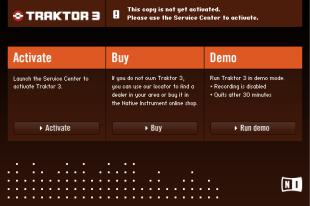
you download the most recent version of TRAKTOR. You should check regularly for updates to TRAKTOR for best performance and compatibility with other audio applications.
4.2.1 Demo Mode
When you start TRAKTOR for the first time, you will see the following screen:
►Choose Activate to start the NI Service Center right away. Consult the Setup Guide for more information about the NI Service Center and activating TRAKTOR. Note that you have to restart TRAKTOR to change from Demo Mode
into Full Mode.
►Click on Buy to purchase a copy of TRAKTOR in the NI online shop or at a dealer in your area. Your standard internet browser will be opened and the Native Instruments website will open.
TRAKTOR 3.3 – 12

►Choose Run Demo to run TRAKTOR in Demo Mode. You can see whether you are in Demo Mode from the Demo Mode graphic in the TRAKTOR Header. Once you have decided to purchase a product, all you need do is unlock the demo version by entering a valid serial number – it then instantly becomes the full version.
The Demo Mode has the following restrictions:
►Audio processing stops after 30 minutes
►Audio recording disabled
►Native Mix Recording disabled
►Fixed broadcasting stream name
4.3 Audio Setup
It is recommended to use TRAKTOR 3 with a multi-channel audio interface so that you can pre-listen to a track in your headphones before bringing it into the main mix.
However, you can also use your built-in soundcard and run TRAKTOR 3, but without the ability to pre-listen (or Cue) tracks.
Multiple audio interfaces are not supported.
TRAKTOR 3.3 – 13

4.3.1 Setting up a Multi-Channel Sound Card
►Click on the Preferences button to open the Preferences window.
►In the Preferences menu, double-click on Audio Setup in the tree on the left.
►Click on Soundcard.
►Click the arrow to drop down the Audio Device menu and select the sound card you want to use.
►Windows sound cards often come with different types of drivers. TRAKTOR 3 requires a fast response of the audio signal, and you should therefore use the ASIO drivers that come with your sound card (if available).
►For Mac OS X, simply select the name of your soundcard.
4.3.2 Configuring the Outputs of a Multi-Channel Sound Card
►Open “Preferences” > “Audio Setup” > “Output Routing”
►Make sure Mixer Mode is set to Internal.
Monitor Outputs
The Monitor Outputs are used to pre-listen to a track by headphones. They are controlled by the PhVol (Phones Volume) and PhMix (Phones Mix) knobs in the internal mixer of TRAKTOR 3.
►Click the arrow next to Monitor Left (Mono) and choose Output 1 of your sound card.
►Click the arrow next to Monitor Right and choose Output 2 of your sound card.
►You can now monitor or pre-listen to tracks through the outputs 1 and 2 of your sound card.
►Click on Mono, if you want to merge both channels into one channel.
It is useful to assign Outputs 1 and 2 for monitoring, as many sound cards with headphones connectors identify them as Outputs 1 and 2.
TRAKTOR 3.3 – 14
Master Outputs
The Master Output is an output pair directed at the audience. It is controlled by the Channel Faders and the Crossfader in the internal mixer of TRAKTOR 3.
►Click the arrow next to Master Left (Mono) and choose Output 3 of your sound card.
►Click the arrow next to Master Right and choose Output 4 of your sound card.
►The Master Outputs of TRAKTOR are now routed through outputs 3 and 4 of your sound card.
Booth Outputs
The Booth Output is an additional output pair directed to the DJ booth.
In large rooms, the sound can be reflected and delayed, making exact beatmatching imprecise or impossible at all. Extra booth boxes help you mix tighter.
The Booth Output Volume is controlled by the Booth panel in the Details section. If you don’t see the Booth panel, read more on page 5.4.4 (Details Section).
►Click the arrow next to Booth Left (Mono) and choose Output 5 of your sound card.
►Click the arrow next to Booth Right and choose Output 6 of your sound card.
►The Master Outputs of TRAKTOR are now routed through outputs 5 and 6 of your sound card.
►Click on Mono, if you want to merge both channels into one channel.
TRAKTOR 3.3 – 15

Record Outputs
The Record Output is an additional output pair you can use for the recording function of TRAKTOR 3. It is controlled by the Audio Recorder panel in the Details section. If you don’t see the Audio Recorder panel, read more on page 5.4.4 (Details Section).
►Click the arrow next to Record Left (Mono) and choose Output 7 of your sound card.
►Click the arrow next to Record Right and choose Output 8 of your sound card.
►The Master Outputs of TRAKTOR are now routed through outputs 7 and 8 of your sound card.
4.3.3 Verifying the Audio Setup
To verify the correct setup of your output channels, play one of the included Demo
Tracks:
►In the Tree Window on the left, double-click on Playlist/ Mixes, then double-click
on Demo Tracks to open the Demo Playlist.
►Right-/ Ctrl-Click on a Demo Track in the List Window and choose Load Track in Deck A. This will load the track in Deck A, and the track Waveform will be displayed.
►Click the Play button underneath Deck A. You should hear output from your speakers.
►If the Waveform does not scroll from right to left after you press the Play button, your Audio Setup is incorrect - refer to the following paragraph and verify your built-in sound card settings.
►If the Waveform does scroll from left to right, but you hear no sound on your built-in speakers, you may have accidentally moved a knob or fader in the mixer and turned down the volume.
TRAKTOR 3.3 – 16
4.4 Test Drive TRAKTOR 3
Now that the sound card is configured and TRAKTOR is up and running, let’s have a little fun by doing a quick mix. For this, we use the Demo Tracks that come with TRAKTOR 3.
The Decks are your virtual turntables, and they behave just like any DJ turntable available on the market. This means that you can not only play back, stop, scroll forward and backward through your tracks, but you can also change the tempo of a track. This makes it possible to match the tempo of two titles and then mix from one to the other just like you would with two turntables and a mixer!
4.4.1 Test Driving on the Included Demo Tracks
We start by loading tracks in Deck A and B and letting them play.
►Click and hold on the first Demo Track in the List Window and drag it into Deck
A. The selected track will load into Deck A and the track Waveform will appear
in the Deck Waveform Display.
►Click and hold on the second Demo Track in the List Window and drag it into Deck B. The track Waveform will appear in the Waveform display of Deck B.
►Make sure the Crossfader on the mixer is all the way to the left, so that only the track playing in Deck A will be heard.
►Click the Play button underneath Deck A.
►The track in Deck A will begin playing and the track tempo will be displayed in the file info section in the upper part of the deck along with other useful information.
►Underneath Deck B, click the Play button. The Demo Track in Deck B will begin to play, but you won’t hear it in the main mix.
TRAKTOR 3.3 – 17
The two tracks will most likely have different tempos and you will need to synchronize their tempo and beat. You can observe current beat offset in the Phase Meter above the waveforms of both decks.
► Click the Sync button above Deck B.
► The tempo of the track in Deck B now matches the tempo of Deck A. ► Click, hold and drag the Crossfader slowly to the right.
► You will hear the track from Deck B slowly blend in with the track in Deck A, eventually becoming the main audible track.
4.4.2 Test Driving on Your own Music
You now have learned enough to make a few mixes with the included tracks. |
|
As you probably already have a collection of music files on your hard drive, you |
|
might want to test drive TRAKTOR 3 with your own music. Nothing is simpler |
|
than that. |
|
► Open a window of the Mac Finder or the Windows Explorer containing the tracks |
|
that you want to play. |
You may not be able to |
► Click and hold one of your tracks and drag it from the external window to the |
%use the Sync function |
TRAKTOR 3 window and into Deck A. |
with your own tracks as their |
► After a short loading time you see the Waveform of your track building up in the |
tempo has to be analyzed in order |
display. |
for this function to work properly. |
► Click and hold one of your tracks and drag it form the external window to the |
Read more about the import and |
TRAKTOR 3 window and into Deck B. |
the BPM detection of TRAKTOR |
► Play and mix the tracks as you have learned in the previous section. |
3 on page 54 (Beatgrids). |
TRAKTOR 3.3 – 18
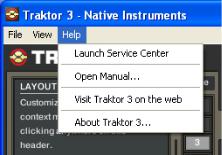
5. User Interface
5.1 Features and Terminology
Before we dive into the wealth of features and options, let’s get an overview about the most important elements of TRAKTORs interface and where to find the most basic features!
5.1.1 Application Menu
!The Application Menu is not visible in Fullscreen mode, therefore all File and View
options can be reached directly from the TRAKTOR graphical user interface. However, the Help menu can only be accessed from the Application Menu.
The Application Menu gives access to basic functions and information about the software.
TRAKTOR 3.3 – 19
File
►Preferences: Opens the Preferences window.
►Audio Setup: Opens the Soundcard sub-menu of the Preferences.
►MIDI Setup: Opens the MIDI Interfaces sub-menu of the Preferences.
►Exit: Closes the program. If there is audio on the Master Output playing, you will have to confirm the closing after a warning message.
View
►Layouts: Choose from 10 different layouts that can be customized, renamed and saved to your convenience.
►Configure Layouts: Check and uncheck different options and see how the GUI changes. Find a detailed description on page 5.4.3 (Layouts).
►Fullscreen: Switches to Fullscreen Mode. Read more about Fullscreen Mode in chapter 5.4.7 (Miscellaneous Display Options).
Help
►Launch Service Center: Opens the NI Service Center, where you can download updates and register your products. Read more about the NI Service Center in the separate Setup Guide installed in the NI Service Center program folder.
►Open Manual: Opens the TRAKTOR 3 user manual.
►Visit TRAKTOR 3 on the web: Opens the TRAKTOR 3 website on the Native Instruments website.
►About TRAKTOR 3: Opens the About window. It contains valuable information about the software such as the exact version number, the serial number and the license type as well as the credits. You can close it by clicking on it.
%You can also open the About window by click-
ing on the TRAKTOR 3 logo.
TRAKTOR 3.3 – 20
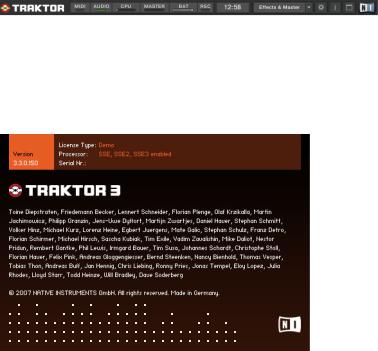
5.1.2 Header
The Header of TRAKTOR 3 is located directly beneath the Application Menu. The elements contained in the Header give access to basic functions of the application.
TRAKTOR Logo
Clicking on the TRAKTOR 3 Logo opens the About window. It contains valuable |
You can also open the |
information about the software such as the version number, the serial number and |
%About window in the |
the license type as well as the credits. You can close it by clicking on it. |
Help section of the Application |
|
Menu. |
TRAKTOR 3.3 – 21

System Monitor
In the middle of the Header you’ll see several displays that give you valuable information about the status of your system:
►MIDI: This displays the status of the connected device (green: a midi device is connected and working; grey: no device is connected or a device is not working properly).
►AUDIO: This displays the status of your sound card. A green LED means, the selected sound card is connected, a red LED means, the selected sound card is not connected.
►CPU: Indicates how much of the CPU-Capacity is available in TRAKTORs internal audio engine. It gives you information about how stressed your system is, and how much headroom you have until you reach the capacity limit. If the bar is fully lit, you most likely will experience audio dropouts.
►Master: Displays the Master Output Level.
►Bat: Gives you quick information about how much power your battery has left; useful if you’re working in Fullscreen Mode.
►Rec: If you are recording it turns green. If the input is clipping it turns red. Reduce the recording gain if the input is clipping.
Clock
This displays the time depending on your computers time; useful if you are working
in Fullscreen Mode.
Layout Selector
This drop-down menu is used to switch between different screen Layouts in TRAKTOR 3. Read more about Layouts in chapter 5.4.3 (Layouts).
Preferences Button
This button opens the Preferences dialog, which allows you to configure TRAKTOR
3 to your personal needs. Read more in chapter 19 (Preferences).
TRAKTOR 3.3 – 22
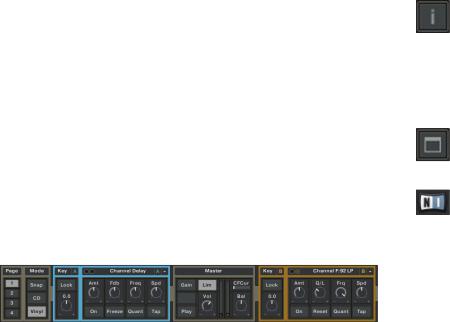
Tooltips/ Console
This button toggles the Tooltips/ Console window on and off.
In Tooltip Mode it displays information about a particular feature and is especially useful for the new user. Hover your mouse arrow over any control feature of the TRAKTOR interface to get information about a feature. In Console Mode it displays software status information. Different to the other panels, you can open and close the Tooltips individually via the Tooltip button in the Header. Click on the small C in the upper right corner of the Tooltip panel to switch between Tooltips and
Console Mode.
Fullscreen Button
Use this button to switch to Fullscreen Mode. Read more about how to configure
Fullscreen Mode in chapter 5.4.7 (Miscellaneous Display Options).
NI Logo
Clicking on the NI Logo opens the About window, like clicking on the TRAKTOR logo.
5.1.3 Details Section
The Details Section is the part directly underneath the Header.
This window is fully customizable and used to display the messages window as well as many different Panels controlling TRAKTOR 3.
Find a detailed explanation of all Details Panels in chapter 5.4.4 (Details Section).
TRAKTOR 3.3 – 23
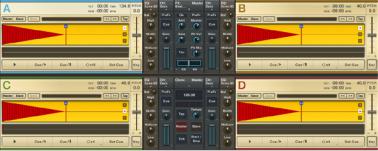
5.1.4 Decks
The Decks have a header showing File Info, Phase Meter, Pitch Bend Buttons, Master, Slave and Sync Buttons, a detailed waveform, a graphical track overview (Stripe) and a few playback control buttons underneath. They are referred to as Deck A and C for the left decks and Deck B and D for the right decks.
Read a detailed explanation of all Deck features in chapter 9 (Controlling the Decks).
TRAKTOR 3.3 – 24

5.1.5 Browser
The Track Browser of TRAKTOR 3
On the left you see the Browser Tree Window, which contains – top down – the
Search Window and the Undo Buttons, the Preview Player, the Browser Tree and the Browser Buttons as well as the Status Bar and the Progress Bar.
On the right you see the List Window with the customizable Browser Columns and
the Favorites.
All detailed information about the Browser can be found in chapter 6 (Using the Track Browser).
5.2 Knob and Fader Control
Although each knob and slider in TRAKTOR has its own unique purpose, their behavior is generally the same. You can control each knob or slider with your mouse or by using a MIDI controller or keyboard shortcuts – called Hotkeys, explained later in chapter 14 (MIDI and Hotkeys).
TRAKTOR 3.3 – 25

5.2.1 Knob and Fader Control
All knobs and faders in TRAKTOR are either controlled by dragging the mouse, by using the mouse wheel or by clicking the small Plus and Minus buttons next to the knob. Dragging the mouse is a good way to make dynamic changes, whereas the Plus and Minus buttons allow more subtle changes and are better suited to set a knob to a specific value. Using the scroll wheel can be used for very fine adjustments or for changing the parameter by steps.
5.2.2 Basic Control
Mouse Drag
►Hold your mouse arrow over a knob, then click, hold and drag the mouse up or down. This will move to the knob clockwise or counter-clockwise.
►Click, hold and drag a knob horizontally. The knob will adjust within a finer range.
►Double-Click on the knob to return it to its default setting.
5.2.3 Advanced Control
Besides the standard mouse click functions explained above, TRAKTOR 3 offers advanced functions utilizing Plus and Minus buttons, the mouse wheel and the right mouse button. If you have a track pad or mouse without a second button, you can utilize these functions by pressing and holding the Ctrl key of your computer keyboard while clicking.
TRAKTOR 3.3 – 26
Plus and Minus Buttons and Mouse Wheel
►Each click on the Plus (+) button next to a knob moves the value of the knob incrementally up.
►Each click on the Minus (-) button next to a knob moves the value of the knob incrementally down.
►Turning the mouse wheel will adjust the parameter by one increment for each step of the wheel.
Sensitivities
TRAKTOR 3 offers five sensitivities for the incremental control of parameters:
►Right-/ Ctrl-Click on the Plus button to open a menu of five sensitivity options: min, fine, default, coarse, switch.
►Select one of the options.
►Click the Plus and Minus buttons or use the mouse wheel to see how the behavior of the knob has changed.
►The small bar of dots below the knob – only visible, when you hover over the control – change accordingly.
►One single dot remains if you have chosen min, the full bar of 9 dots appears, if you have chosen switch.
Right-/ Ctrl-Click Functions
►Right-/ Ctrl-Click + hold and drag a knob. A Ghost Pointer will appear in red, although the knob itself will not move.
►Keep holding the right mouse button, then left-click and hold. This will bring the knob to the value of the Ghost Pointer.
►Keep holding the right mouse button and let go the left mouse button. The knob will return to its last position and the red Ghost Pointer remains visible.
►If you want the knob to stay at the value of the Ghost Pointer, simply release the right mouse button after the knob has reached the value of the Ghost Pointer. The red Ghost Pointer will disappear, and you can depress the left mouse button as well.
TRAKTOR 3.3 – 27

5.3 Mouse Modes
The mouse can be used to Cue, Play and Pause a track. There are 3 available Mouse Control Modes: Snap, CD and Vinyl. You can switch between Mouse Modes by pushing the respective button in the Mode Details Panel. If you can’t find the Mode panel, refer to the Layout chapter for learning how to insert the Mode panel into one of your Detail views.
If you intend to often switch between Mouse Modes, make sure that the Mode panel is included on each of your Details pages. If you intend to use only one Mouse Mode you can remove the Mode panel from all your Details pages.
5.3.1 Snap Mode (Waveform)
In this mode the mouse pointer will snap to either Beats, Cue Points or Beatgrid lines.
►Hold your mouse pointer over the Waveform. Red Snap points appear at each
Beat and Cue Point.
►Click and hold. This snaps the cursor to the nearest Beat and plays the track as long as you hold the button. This is the same as Cue/ Pause.
►Release the button to return to the last Cue Point.
►To avoid returning, press the right mouse button before releasing the left one to switch to permanent playback.
►Clicking on the Waveform with right-/ ctrl-click cues the song to the target but starts playback only when you release the mouse button.
TRAKTOR 3.3 – 28
5.3.2 Snap Mode (Stripe)
►Select Snap from the Mode Details Panel.
►Hold your mouse pointer over the Stripe Waveform.
►When moving the mouse back and forth, small, red Snap points will appear
along the Stripe Waveform.
►Click to move the cursor to the Snap point in the Stripe Waveform.
5.3.3 CD Mode (Waveform)
This triggers a stutter loop known from pitchable CD-players while clicking and holding the Waveform.
►Click and hold on the Waveform.
►The Deck will play a short, consistent loop as long as you hold the mouse button.
►While holding the button pressed you can adjust the position of the loop by horizontally dragging the Waveform.
►To set a Cue Point right before a Beat, move the loop as close as you can towards the beat coming from the right side until you hear the very first millisecond of the beat entering the loop. Release the left mouse button and the track will pause exactly before the beat.
►Right-/ Ctrl-Click and hold the Waveform, then release the mouse button to start playback.
5.3.4 CD Mode/ Vinyl Mode (Stripe)
►Select either CD or Vinyl from the Mode module.
►Click and hold anywhere on the Stripe Waveform.
►Move the mouse backward or forward. This will navigate through the Stripe Waveform similar to moving a slider.
TRAKTOR 3.3 – 29
5.3.5 Vinyl Mode
In this mode the Waveform can be manipulated like a vinyl record and the mouse pointer won’t snap to beats in the Waveform.
►Click and hold the track Waveform. This is like putting your hand on a vinyl record to pause playback.
►While holding the mouse button, move the mouse backward and forward. This moves the Waveform similar to scratching a vinyl record.
►Release the mouse button. The track will begin playing from the point at which you release it.
►Right-/ Ctrl-Click on the Waveform to start and stop playback.
5.4 Adjusting the Look of TRAKTOR
Whether you would like to take advantage of advanced features or simply wish to perform basic mixing, the TRAKTOR interface can be adjusted for your specific needs.
5.4.1 Scalability
The TRAKTOR interface can be scaled to the size of your liking:
►Click + hold and drag the bottom-right corner of the TRAKTOR window. This will expand and/ or contract the TRAKTOR interface while simultaneously resizing all TRAKTOR sections.
TRAKTOR 3.3 – 30
